MAT 350: Introduction and What to Expect
September 3, 2025
What Are We Here For?
\[\left\{\begin{array}{lcl} 2x_1 + 5x_2 & = & 13\\ -2x_1 + 3x_2 & = & 11\end{array}\right.\]
What Are We Here For?

\[\left\{\begin{array}{lcl} 2x_1 + 5x_2 & = & 13\\ -2x_1 + 3x_2 & = & 11\end{array}\right.\]
What Are We Here For?
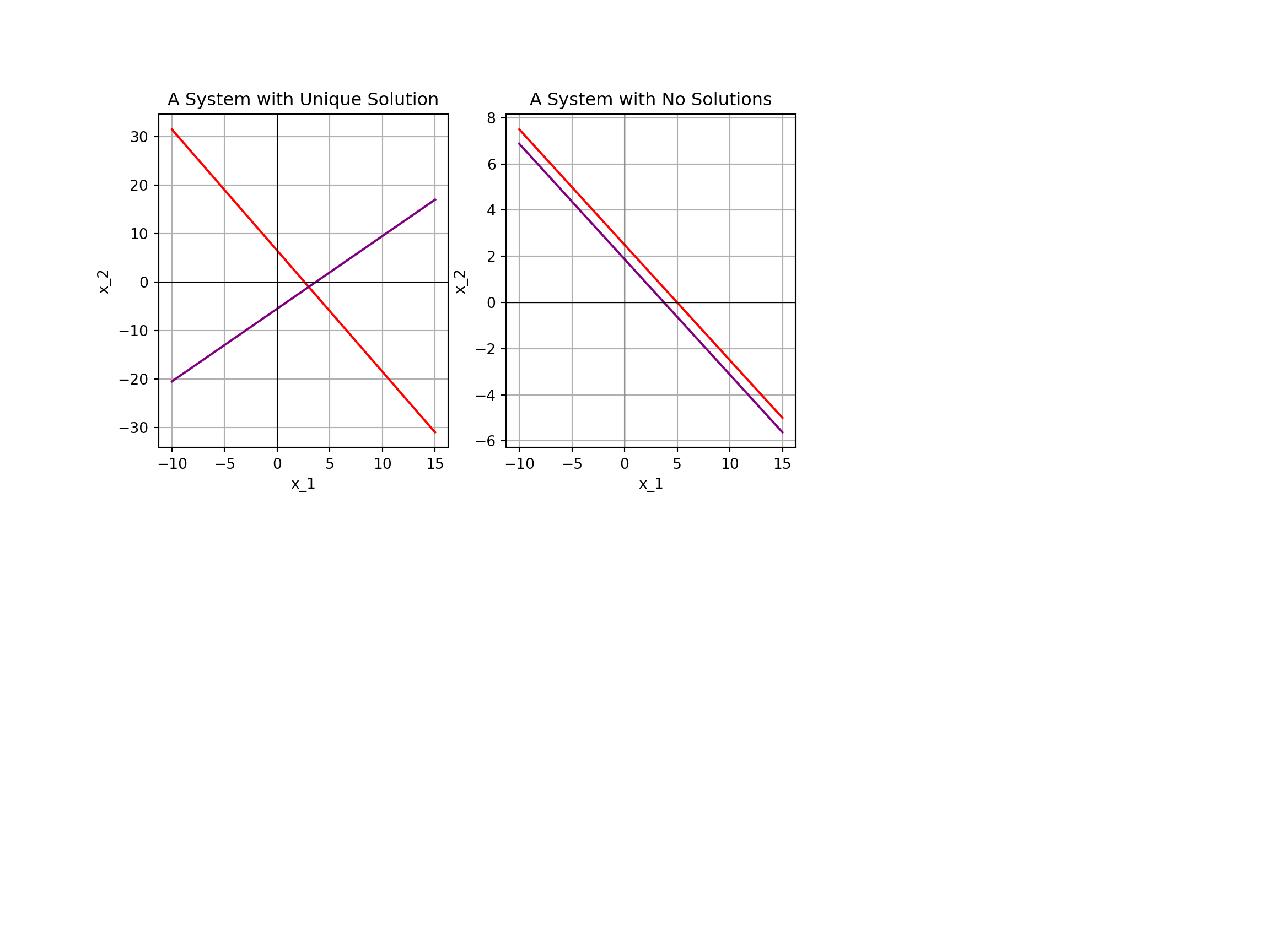
\[\left\{\begin{array}{lcl} 2x_1 + 5x_2 & = & 13\\ -2x_1 + 3x_2 & = & 11\end{array}\right.\]
\[\left\{\begin{array}{lcl} 2x_1 + 4x_2 & = & 10\\ 4x_1 + 8x_2 & = & 15\end{array}\right.\]
What Are We Here For?
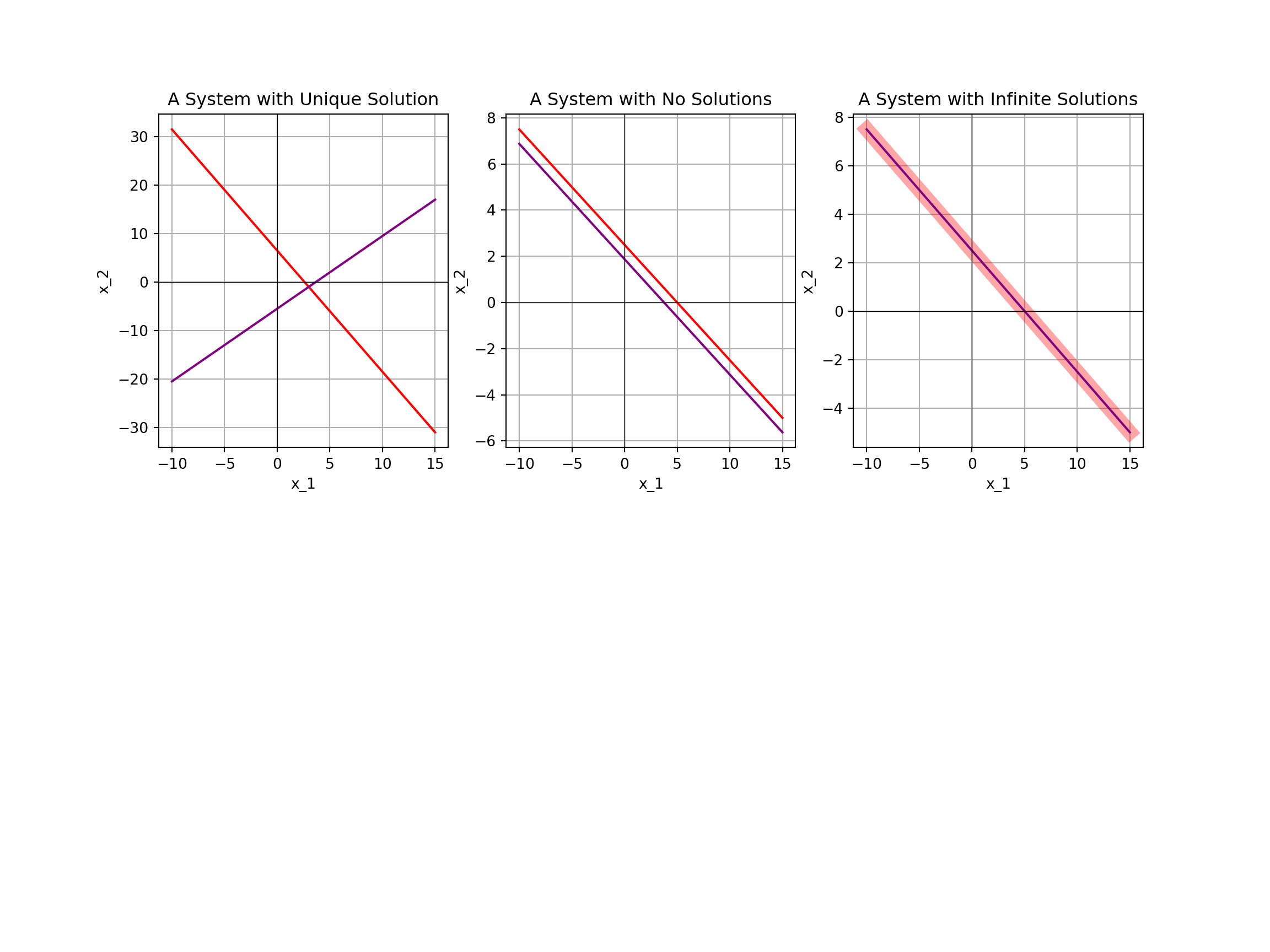
\[\left\{\begin{array}{lcl} 2x_1 + 5x_2 & = & 13\\ -2x_1 + 3x_2 & = & 11\end{array}\right.\]
\[\left\{\begin{array}{lcl} 2x_1 + 4x_2 & = & 10\\ 4x_1 + 8x_2 & = & 15\end{array}\right.\]
\[\left\{\begin{array}{lcl} 2x_1 + 4x_2 & = & 10\\ -4x_1 - 8x_2 & = & -20\end{array}\right.\]
What Are We Here For?
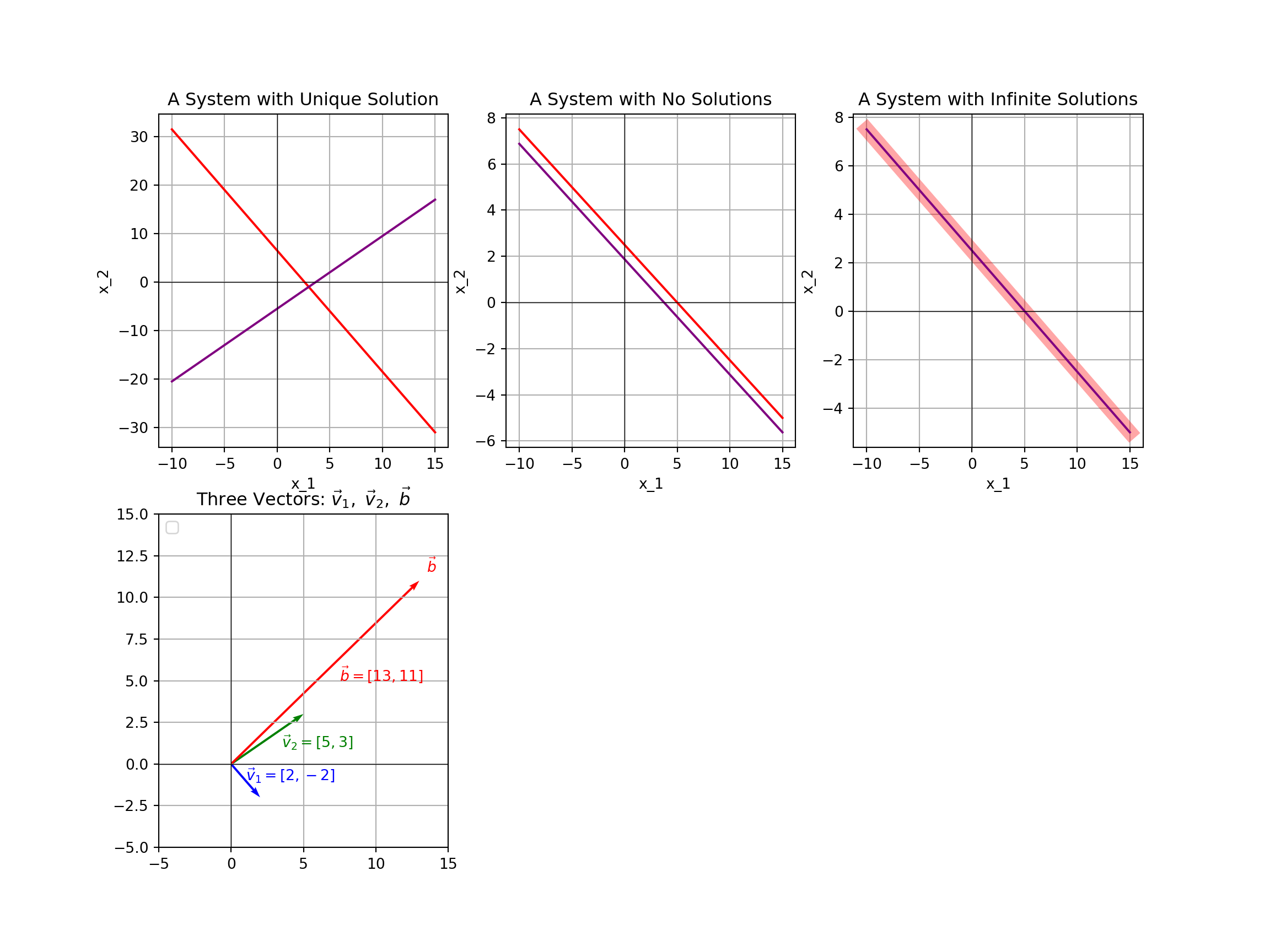
\[\left\{\begin{array}{lcl} 2x_1 + 5x_2 & = & 13\\ -2x_1 + 3x_2 & = & 11\end{array}\right.\]
\[\left\{\begin{array}{lcl} 2x_1 + 4x_2 & = & 10\\ 4x_1 + 8x_2 & = & 15\end{array}\right.\]
\[\left\{\begin{array}{lcl} 2x_1 + 4x_2 & = & 10\\ -4x_1 - 8x_2 & = & -20\end{array}\right.\]
What Are We Here For?
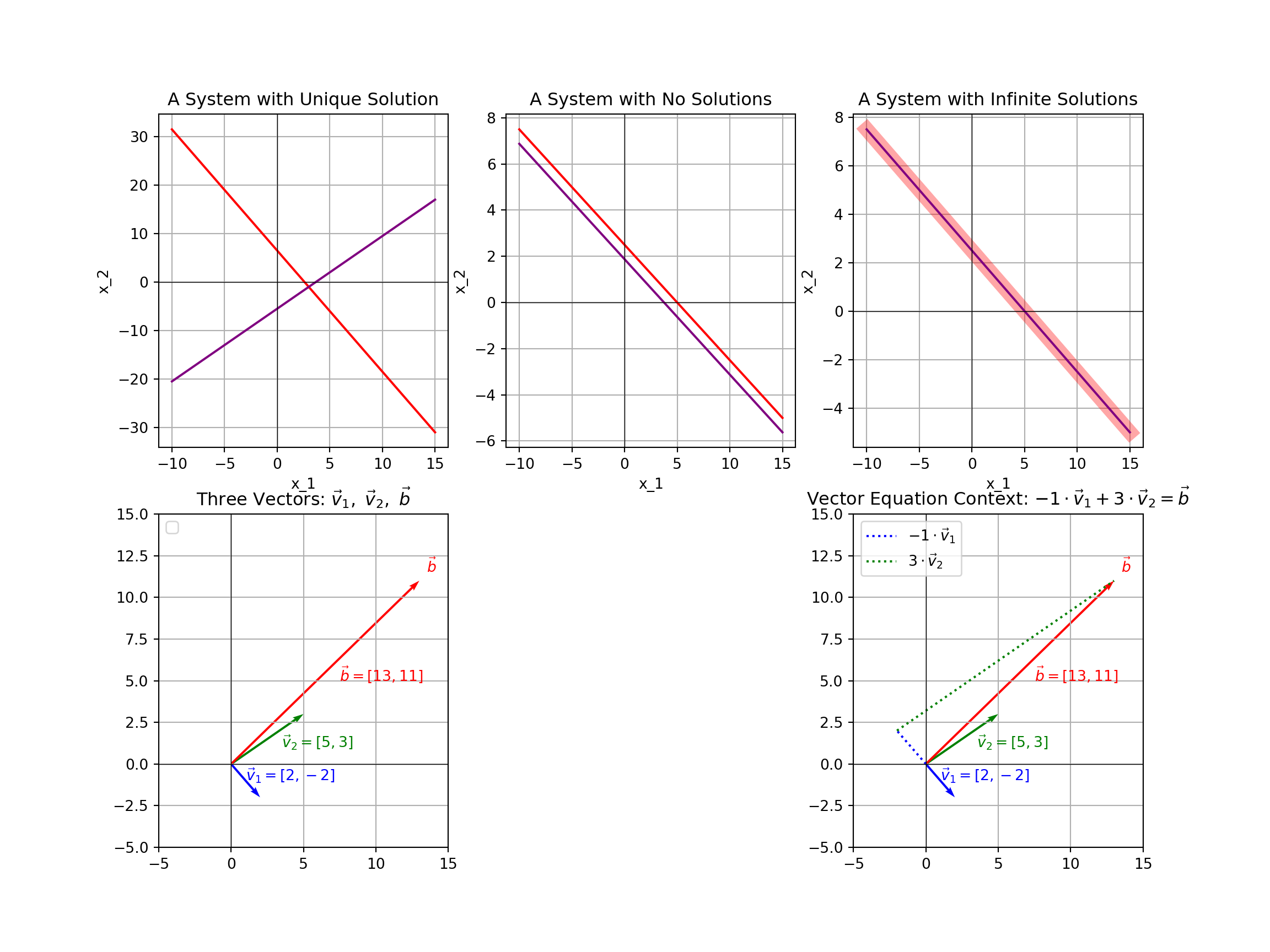
\[\left\{\begin{array}{lcl} 2x_1 + 5x_2 & = & 13\\ -2x_1 + 3x_2 & = & 11\end{array}\right.\]
\[\left\{\begin{array}{lcl} 2x_1 + 4x_2 & = & 10\\ 4x_1 + 8x_2 & = & 15\end{array}\right.\]
\[\left\{\begin{array}{lcl} 2x_1 + 4x_2 & = & 10\\ -4x_1 - 8x_2 & = & -20\end{array}\right.\]
\[c_1\begin{bmatrix} 2\\ -2\end{bmatrix} + c_2\begin{bmatrix} 5\\ 3\end{bmatrix} = \begin{bmatrix} 13\\ 11\end{bmatrix}\]
What Are We Here For?
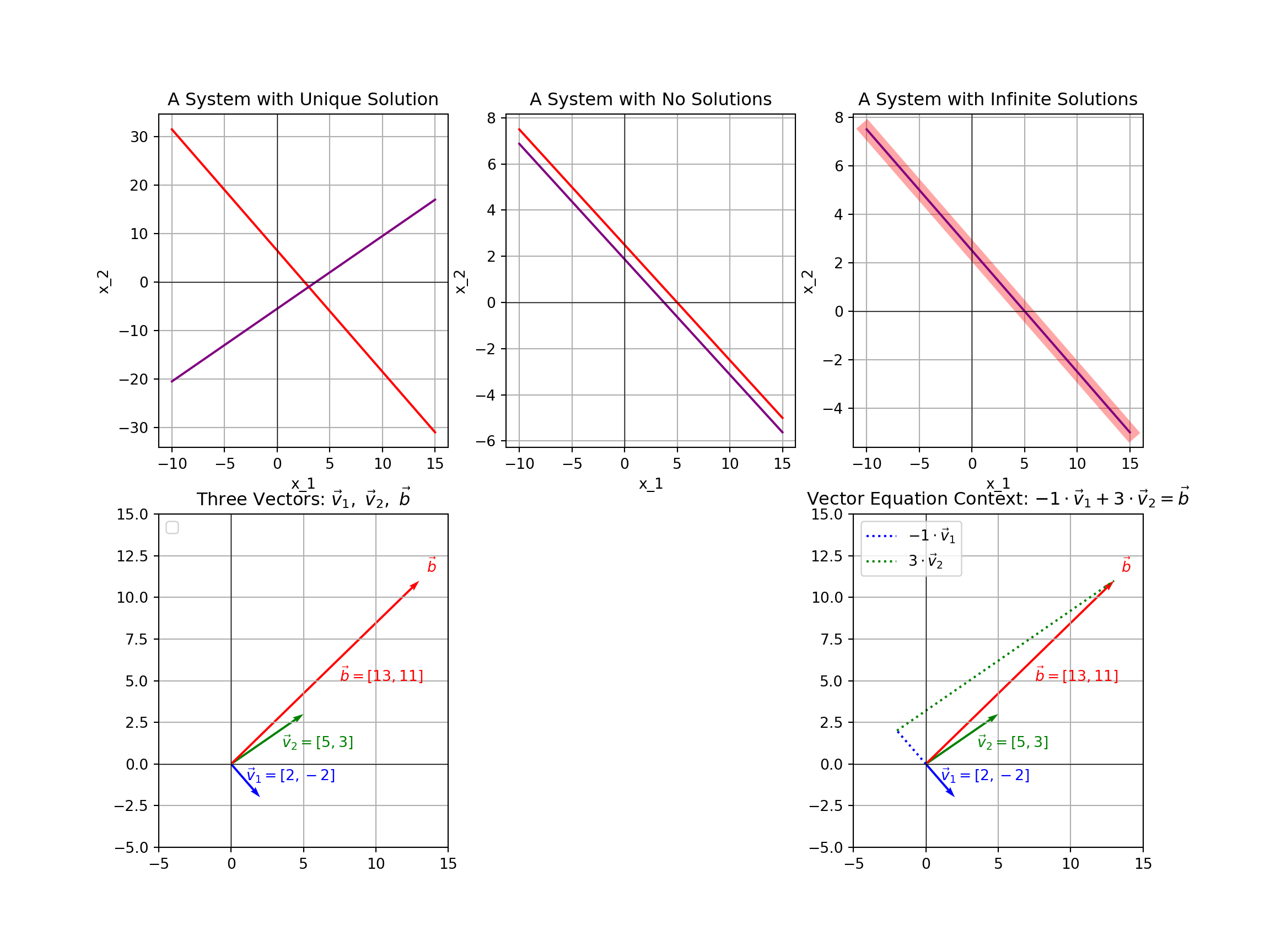
\[\left\{\begin{array}{lcl} 2x_1 + 5x_2 & = & 13\\ -2x_1 + 3x_2 & = & 11\end{array}\right.\]
\[\left\{\begin{array}{lcl} 2x_1 + 4x_2 & = & 10\\ 4x_1 + 8x_2 & = & 15\end{array}\right.\]
\[\left\{\begin{array}{lcl} 2x_1 + 4x_2 & = & 10\\ -4x_1 - 8x_2 & = & -20\end{array}\right.\]
\[c_1\begin{bmatrix} 2\\ -2\end{bmatrix} + c_2\begin{bmatrix} 5\\ 3\end{bmatrix} = \begin{bmatrix} 13\\ 11\end{bmatrix}\]
\[\text{...and more...}\]
Syllabus
Major Highlights from the Syllabus: I’ll ask you to read the syllabus, but the most important items are on the following slides.
Instructor and Office Hours
Instructor: Dr. Adam Gilbert
e-mail address: a.gilbert1@snhu.edu
Office: Robert Frost Hall, Room 311
Office Hours (please visit!):
- Tuesdays 11:00am - 12:30pm
- Wednesdays 9:00am - 10:30am
- Fridays 1:00pm - 3:00pm
Required Resources
First and foremost…everything is free!
Main Textbook: We are following Understanding Linear Algebra by David Austin, but myself and Professor Spaulding have adapted a custom Python version
Python via Google Colab or a local Python installation is recommended but not required
Online Homework at MyOpenMath is a required component of this course
- The CourseID and Enrollment Key are available in the Welcome! announcement on BrightSpace.
Grading Scheme
| Grade Item | Value |
|---|---|
| Homework (~12) | 25% |
| Row-Reduction Gateway Exam | 15% |
| Exams (2) | 40% |
| Final Exam | 20% |
Explanations of Grade Items
Homework: Practicing is critical to your success in linear algebra. You’ll get unlimited attempts (unpenalized) at all problems on each assignment, and you’ll be graded 50% on completion and 50% on correctness.
- Late Passes: You get three free (no penalty) late passes to open up assignments again until the end of the semester. No additional late passes will be provided though.
Row-Reduction Gateway: Row-reduction is a procedure that we’ll utilize over and over again in linear algebra. This gateway can be taken many times and is an “all or nothing” component of the grading scheme.
Exams: We’ll have two exams during the semester – each will include a group exam (20%) and an individual exam (80%), where the group exam only counts if your group score exceeds your individual score.
Final Exam: The final exam will occur in two parts during the last week of the semester. The first part is required and the second part is optional. The final exam can be used to improve earlier exam grades.
Brightspace
- Announcements
- Gradebook
- Go to the webpage for everything else
Course Webpage
I’ve built a webpage to organize our course content.
Syllabus
Tentative timeline
- Links to full notes (in Jupyter/Colab notebook format)
- Links to the discussion slide versions of those notes
- Assignment reminders
- Optional, but recommended, 3Blue1Brown high-level overview videos
What’s Class Like?
- Some lecture is going to be necessary here
- I have complete sets of notes for you and will attempt to keep up with building slides if you want them
- I hope to spend significant class time on collaborative discussion and problem-solving
A Note on Approach to Class
- I’m open to change in all of my courses.
- If the structure isn’t working for you, let’s chat and see what changes we can make to improve your experience.
- If you don’t want to tell me in person, leave an anonymous note under my office door.
My goal in this course is for all of you to learn as much about linear algebra and its applications as possible – we can’t achieve that if you don’t feel like you are benefiting from our class meetings.
A Road Map to Our Semester
We’ll be discussing a lot of material in MAT 350. Here is a very generic road map of what we will discuss. Starting now.
A Linear Algebra Road Map
Motivation for Linear Algebra (Today)
Foundations
- Vectors and Arithmetic
- Matrices and Arithmetic
Linear Systems
- Solving Systems
- Pivots
- Solution Spaces
Vector Equations
- Linear Combinations
- Linear Independence
- Spanning Sets
- Bases
Matrix Transformations
Matrix Equations
- Invertibility
- Determinants
- More with Bases and Subspaces
Eigenvectors and Eigenvalues
Diagonalization
Discrete Dynamical Systems
Markov Chains and Google Page Rank
Advice for Success
Linear Algebra is a much different type of math class than Calculus. Please consider the following pieces of advice.
We’ll be doing a lot of arithmetic (addition, subtraction, multiplication, and division) – it is easy to make mistakes, so keeping really organized work is key.
Do “future you” some favors…
- Keep very organized work – don’t try to keep everything condensed and tiny
- Don’t skip steps
- Document what is happening at each step
Linear algebra is likely the first math class you are encountering where definitions are extremely important.
- Study and practice with definitions
- If you don’t remember what something means, ask a question
Keep yourself grounded – while it may seem like we are covering lots of material, procedures and ideas are very often recycled and repurposed.
As with any math class – if you’re having difficulty with concepts or procedures, come visit office hours or the walk-in tutoring center.
- Misunderstandings tend to snowball and compound, causing you to fall further behind if they are left unaddressed.
Conventions and Definitions Before We Continue
Convention for Writing linear Equations: We’ll write all of our linear equations to include all variable terms on the left side of the equation and pushing the constant term to the right. That is, we’ll write \(x_1 + 8x_2 = -7\) rather than \(x_1 = -8x_2 -7\)
- Why? Consistency. We can write any linear equation this way, regardless of the number of variables included or whether the line is vertical or horizontal.
Terminology for Linear Equations: Given a linear equation of the form \(a_1x_1 + a_2x_2 + \cdots + a_nx_n = b\), we say that
- \(a_1, a_2,\cdots, a_n\) are the coefficients, sometimes called scalars or weights in different contexts.
- \(x_1, x_2,\cdots, x_n\) are the variables (or unknowns).
- the constant \(b\) is sometimes referred to as the constant term, intercept, or right-hand side.
Conventions and Definitions Before We Continue (Cont’d)
Systems of Linear Equations (or linear systems) are a collection of linear equations written with a common set of unknowns and designed to be solved simultaneously.
Solution for Linear Systems (or solution) is a collection of scalars (numbers) \(x_1 = s_1, x_2 = s_2, \cdots, x_n = s_n\) that satisfy all of the equations in the system simultaneously.
Solution Space (or solution set) for a linear system is the collection of all solutions to a given linear system.
- Remember that for any give system we may have 0, 1, or infinitely many solutions. That is, the solution space is either empty, contains a single element, or contains infinitely many elements.
Solving Our First System
Example 1: Solve the linear system \(\left\{\begin{array}{rcr} 2x_1 + 5x_2 & = & 13\\ -2x_1 + 3x_2 & = & 11\end{array}\right.\)
- Add the first and second equations together to get a new equation \(0x_1 + 8x_2 = 24\), or more simply \(8x_2 = 24\).
- Solve this new equation for \(x_2\) to find that \(x_2 = 3\).
- Plug your newly discovered value of \(x_2\) into either equation to eliminate one of the unknowns, resulting in a single equation with one unknown that can be solved for.
\[\begin{align} 2x_1 + 5x_2 &= 13 \end{align}\]
Solving Our First System
Example 1: Solve the linear system \(\left\{\begin{array}{rcr} 2x_1 + 5x_2 & = & 13\\ -2x_1 + 3x_2 & = & 11\end{array}\right.\)
- Add the first and second equations together to get a new equation \(0x_1 + 8x_2 = 24\), or more simply \(8x_2 = 24\).
- Solve this new equation for \(x_2\) to find that \(x_2 = 3\).
- Plug your newly discovered value of \(x_2\) into either equation to eliminate one of the unknowns, resulting in a single equation with one unknown that can be solved for.
\[\begin{align} 2x_1 + 5x_2 &= 13\\ \implies 2x_1 + 5\left(3\right) &= 13 \end{align}\]
Solving Our First System
Example 1: Solve the linear system \(\left\{\begin{array}{rcr} 2x_1 + 5x_2 & = & 13\\ -2x_1 + 3x_2 & = & 11\end{array}\right.\)
- Add the first and second equations together to get a new equation \(0x_1 + 8x_2 = 24\), or more simply \(8x_2 = 24\).
- Solve this new equation for \(x_2\) to find that \(x_2 = 3\).
- Plug your newly discovered value of \(x_2\) into either equation to eliminate one of the unknowns, resulting in a single equation with one unknown that can be solved for.
\[\begin{align} 2x_1 + 5x_2 &= 13\\ \implies 2x_1 + 5\left(3\right) &= 13\\ \implies 2x_1 + 15 &= 13 \end{align}\]
Solving Our First System
Example 1: Solve the linear system \(\left\{\begin{array}{rcr} 2x_1 + 5x_2 & = & 13\\ -2x_1 + 3x_2 & = & 11\end{array}\right.\)
- Add the first and second equations together to get a new equation \(0x_1 + 8x_2 = 24\), or more simply \(8x_2 = 24\).
- Solve this new equation for \(x_2\) to find that \(x_2 = 3\).
- Plug your newly discovered value of \(x_2\) into either equation to eliminate one of the unknowns, resulting in a single equation with one unknown that can be solved for.
\[\begin{align} 2x_1 + 5x_2 &= 13\\ \implies 2x_1 + 5\left(3\right) &= 13\\ \implies 2x_1 + 15 &= 13\\ \implies 2x_1 &= -2 \end{align}\]
Solving Our First System
Example 1: Solve the linear system \(\left\{\begin{array}{rcr} 2x_1 + 5x_2 & = & 13\\ -2x_1 + 3x_2 & = & 11\end{array}\right.\)
- Add the first and second equations together to get a new equation \(0x_1 + 8x_2 = 24\), or more simply \(8x_2 = 24\).
- Solve this new equation for \(x_2\) to find that \(x_2 = 3\).
- Plug your newly discovered value of \(x_2\) into either equation to eliminate one of the unknowns, resulting in a single equation with one unknown that can be solved for.
\[\begin{align} 2x_1 + 5x_2 &= 13\\ \implies 2x_1 + 5\left(3\right) &= 13\\ \implies 2x_1 + 15 &= 13\\ \implies 2x_1 &= -2\\ \implies x_1 &= -1 \end{align}\]
- Identify and describe the solutions we’ve discovered. From the work above, we see that a solution to the system exists and that solution is \(\boxed{~\displaystyle{x_1 = -1} \text{ and } \displaystyle{x_2 = 3}~}\).
Solving Our First Vector Equation
Example 2: Solve the vector equation \(c_1\begin{bmatrix} 2\\ -2\end{bmatrix} + c_2\begin{bmatrix} 5\\ 3\end{bmatrix} = \begin{bmatrix} 13\\ 11\end{bmatrix}\)
- Notice that the vector equation is equivalent to \(\begin{bmatrix} 2c_1\\ -2c_1\end{bmatrix} + \begin{bmatrix} 5c_2\\ 3c_2\end{bmatrix} = \begin{bmatrix} 13\\ 11\end{bmatrix}\)
- This is further equivalent to \(\begin{bmatrix} 2c_1 + 5c_2\\ -2c_1 + 3c_2\end{bmatrix} = \begin{bmatrix} 13\\ 11\end{bmatrix}\)
- This is equivalent to our system from Example 1, so the solution is \(\boxed{~\displaystyle{c_1 = -1 \text{ and } c_2 = 3}~}\)
Benefits to Different Contexts
The linear system from Example 1 is a question about the point of intersection between two lines, while the vector equation from Example 2 is a question about linear combinations and spans (which we’ll see later in our course)
Put more simply, the vector equation from Example 2 asks whether it is possible to begin from \(\begin{bmatrix} 0\\ 0\end{bmatrix}\) (the origin) and walk only in the directions of \(\begin{bmatrix} 2\\ -2\end{bmatrix}\) and \(\begin{bmatrix} 5\\ 3\end{bmatrix}\) and arrive at the location \(\begin{bmatrix} 13\\ 11\end{bmatrix}\)
Benefits to Different Contexts
The linear system from Example 1 is a question about the point of intersection between two lines, while the vector equation from Example 2 is a question about linear combinations and spans (which we’ll see later in our course)
Put more simply, the vector equation from Example 2 asks whether it is possible to begin from \(\begin{bmatrix} 0\\ 0\end{bmatrix}\) (the origin) and walk only in the directions of \(\begin{bmatrix} 2\\ -2\end{bmatrix}\) and \(\begin{bmatrix} 5\\ 3\end{bmatrix}\) and arrive at the location \(\begin{bmatrix} 13\\ 11\end{bmatrix}\)
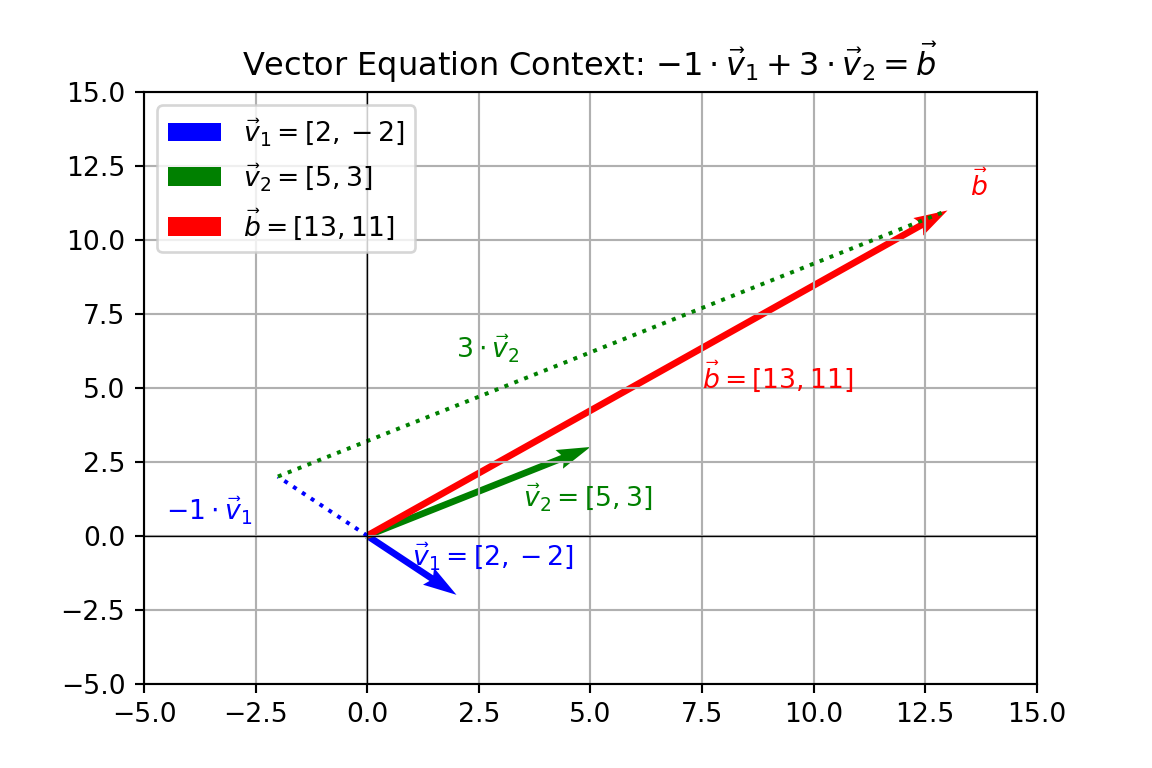
Benefits to Different Contexts (Cont’d)
The vector equation context becomes quite useful because, while it is hard to visualize the meaning of a solution set to the system
\[\left\{\begin{array}{lcl} 5x_1 + 4x_2 - 2x_3 + x_4 & = & 8\\ -x_1 + x_2 - x_3 + x_4 & = & 5\\ -4x_1 + 3x_2 + 8x_3 - 4x_4 & = & -7\\ 2x_1 + 3x_2 - x_3 - x_4 & = & -12\end{array}\right.\]
It is much easier to grasp the meaning of the solution set to the vector equation
\[c_1\begin{bmatrix} 5\\ -1\\ -4\\ 2\end{bmatrix} + c_2\begin{bmatrix} 4\\ 1\\ 3\\ 3\end{bmatrix} + c_3\begin{bmatrix} -2\\ -1\\ 8\\ -1\end{bmatrix} + c_4\begin{bmatrix} 1\\ 1\\ -4\\ -1\end{bmatrix} = \begin{bmatrix} 8\\ 5\\ -7\\ -12\end{bmatrix}\]
Benefits to Different Contexts (Cont’d)
It is much easier to grasp the meaning of the solution set to the vector equation
\[c_1\begin{bmatrix} 5\\ -1\\ -4\\ 2\end{bmatrix} + c_2\begin{bmatrix} 4\\ 1\\ 3\\ 3\end{bmatrix} + c_3\begin{bmatrix} -2\\ -1\\ 8\\ -1\end{bmatrix} + c_4\begin{bmatrix} 1\\ 1\\ -4\\ -1\end{bmatrix} = \begin{bmatrix} 8\\ 5\\ -7\\ -12\end{bmatrix}\]
We have four directional vectors that we can walk in – and we wonder whether we can arrive at a particular point in space.
Homework (Part I)
Complete the Week One assignment in BrightSpace
Complete Homework 0 on MyOpenMath
- See Welcome Announcement on BrightSpace for Course ID and Enrollment Key
Homework (Part II)
Stop by my office (Robert Frost 311), say hi and let’s briefly chat about the following:
- Why are you taking this course?
- What do you hope to get out of it?
- What can I do to make it likely that you have a good experience in this course?
Next Time…
\(\Huge{\text{Vectors and Arithmetic}}\)